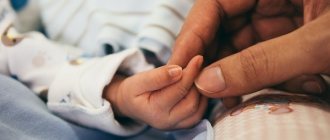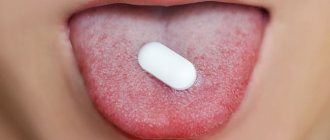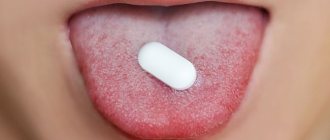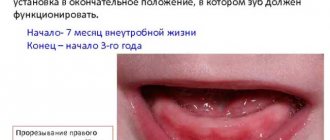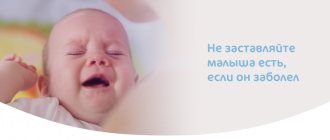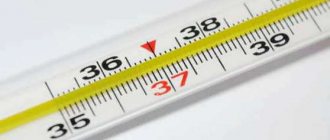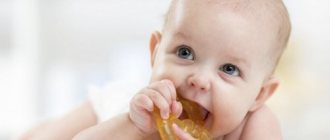Teething is a process characterized by the axial movement of teeth from a non-functional position (from the bone jaw tissue) to a functional position (on the surface of the alveolar process and gums). Most often, the formation of a temporary bite causes a lot of inconvenience, not only to the baby, but also to his worried parents. In this article from the “Pediatric Dentistry” section, we will try to figure out in what order baby teeth erupt, and what symptoms accompany the development of this process.
Teething: sequence and timing
Normally, teething in babies occurs according to the scheme below:
- central incisors: at 6 months. – in the lower dentition, at 8 months. – on the upper jaw;
- lateral incisors: at 10 months. – in the top row, at 11-13 months. – on the lower jaw;
- first molars (at one year of age);
- canines in the upper row (1 year 4 months);
- canines in the bottom row (1 year 6 months);
- second molars on both jaws (2 years).
The timing of the appearance of the first teeth can vary under the influence of many factors, including:
- toxicosis during pregnancy;
- the presence of Rh conflict;
- prematurity;
- receiving intracranial injury during childbirth;
- infectious diseases;
- congenital hypothyroidism;
- rickets;
- pathology of the pituitary gland;
- neonatal sepsis;
- refusal to breastfeed the baby;
- noticeable weakening of the immune system.
It has been proven that in first-born children, teething occurs much earlier than in infants born at a later time. Boys' first teeth appear later than in girls, while in children of old-time mothers - significantly earlier than in babies born to young parents.
Clinical manifestations of different types of seizures
Different pathologies are characterized by a variety of muscle contractions. Seizures are classified into the following types:
- Small ones. They manifest themselves in the form of weak twitching of the limbs, blinking, trembling of the eyelids, and facial movements. Minor seizures are often not noticed by parents.
- Tonic. Characteristic of premature babies. They are manifested by pronounced tension in the muscles of the body, throwing back the head. Respiratory cessation may occur due to spasm of the airways.
- Clonic. They may affect one or more muscle groups, depending on this they are divided into:
- focal, or focal (occur in one area of the body);
multifocal, or multifocal (spread to several parts of the body);
- generalized (muscles of the whole body are involved).
- Myoclonic. Manifested by convulsive twitching of the muscles of one or more limbs.
- Febrile. Triggered by hyperthermia (high temperature).
With clonic convulsions, the child loses consciousness, and blueness (cyanosis) of the skin is observed.
Young children may experience convulsive twitching when falling asleep or during sleep. If they are not accompanied by specific symptoms and elevated body temperature, then they are considered safe and are regarded as the body’s reaction to the formation of the nervous system and the development of its activity.
If a convulsive attack develops, when breathing stops and consciousness is impaired, the child needs emergency medical care.
Teething symptoms
There is an opinion that the appearance of the first teeth is accompanied by the development of a whole complex of pathological processes (fever, the appearance of a rash, abnormal stool, vomiting, convulsions, etc.). In fact, the formation of a temporary bite is a natural process that is not characterized by the symptoms described above. Pathologies detected during the teething period are most often manifestations of infectious diseases or a consequence of changes in diet.
In particular, factors that can lead to the appearance of unpleasant symptoms include:
- introduction of artificial complementary foods;
- hypovitaminosis;
- acute viral infections;
- stomatitis;
- tonsillitis;
- runny nose;
- otitis;
- vaccination, etc.
The true symptoms of teething are:
- hyperemia and gradual swelling of the gums;
- the appearance of a small bluish hematoma on the gum tissue;
- slight bleeding from the gums;
- wet cough;
- mild itching caused by mechanical irritation of sensitive nerve fibers in the gum tissue;
- increased salivation;
- various somnological disorders;
- sharp deterioration in appetite;
- tearfulness, capriciousness.
The danger of redness of the throat during this period
During teething, the baby's body weakens and becomes vulnerable to pathogenic bacteria or colds.
When a baby is teething, the child endlessly puts various objects into his mouth, which are not always sterilely clean. It introduces an infection and hyperemia of the tonsils occurs (tonsillitis, pharyngitis, sore throat occur), this is a very dangerous disease for such young children.
If some symptoms intensify and last more than 2-3 days (fever, red sore throat, runny nose with yellow or green discharge, cough or wheezing in the chest), you should consult a pediatrician.
Redness in the throat of a baby may be a sign of diseases:
- mechanical, thermal damage;
- tonsillitis;
- pharyngitis;
- laryngitis;
- tonsillitis;
- allergic reaction;
- ARVI;
- acute respiratory infections;
- diseases of the stomach, esophagus;
- problems with the nasopharynx.
First aid for teething
When baby teeth appear, the baby may require not only parental care, but also medical attention. The dentist may recommend that parents use anesthetic dental gels and treat the affected areas of the gums with decoctions of sage, oak bark or soda solution. If the pain is severe, the baby may be prescribed paracetamol, ibuprofen and other systemic painkillers.
To ease the discomfort that a child experiences when teething, it is necessary to use teethers - specialized devices made of rubber or plastic that the baby can bite and gnaw on without risking damage to the soft gum tissue. In addition, it is advisable to regularly massage the child’s gums with a finger wrapped in a clean, damp bandage.
Galvanic syndrome
This is the case when physics interferes with physiology. Painful sensations are caused by microscopic current discharges, which have an extremely unpleasant effect on the vulnerable mucous membrane of the mouth. The syndrome occurs due to the fact that in your mouth there are fillings and other dental structures that contain many metals and alloys that are widely used in modern dentistry. An artificial tooth contains a lot of conductive materials and as a natural result: the current irritates the delicate mucous membrane, which leads to the development of inflammation, and this process can spread further to the throat. Eliminating this problem is quite simple, although it is associated with material and aesthetic losses. It is necessary to remove the current conductor - the dental structure. Experience shows that the pain disappears almost instantly, although the inflamed tissues will need time to recover. Well, there is a need to replace the removed structures. Usually, in this case, the doctor prescribes you a course of restorative immunotherapy to minimize all the negative effects of irritants. And problems with missing teeth will be solved by ceramic materials. They are beautiful, natural and have no problems with conductivity.
Caring for emerging teeth
Teething is an absolute reason for making the first visit to the pediatric dentist. During the consultation, the doctor identifies all deviations in the structure of the child’s dental apparatus, assesses the condition of the frenulum of his lips and tongue, draws up a dental care plan and a plan for preventive visits to the dental clinic.
It is advisable to brush emerging teeth twice a day. Initially, you should use a baby silicone brush or a small piece of gauze without toothpaste for cleaning. A regular toothbrush can be used when the child is one year old, and toothpaste when he reaches two years of age. In addition, it is important to pay attention to the process of enamel mineralization. In particular, it is necessary to limit the consumption of sweets and include foods enriched with calcium, phosphorus and ascorbic acid in the baby’s diet.
Common symptoms of a seizure
What should parents pay attention to in order to contact a specialist in time and avoid dangerous complications? Convulsions in children under 1 year of age manifest themselves as follows:
- trembling of the chin, movements of the jaw, as if the baby was chewing something;
- twitching of eyelids, facial muscles;
- frequent eye rolling;
- rhythmic movements of arms and legs;
- constant twitching of the limbs during sleep;
- disturbance of the rhythm of heart contractions and respiratory movements (up to respiratory arrest);
- hiccups and constant yawning due to oxygen deprivation.
Convulsions may be accompanied by nausea and vomiting, and in premature babies - sharp loud cries. The appearance of seizures is provoked by excessive motor activity in children.
Other manifestations of convulsive syndrome include bluish skin, fever, and loss of consciousness.
The order of changing baby teeth in children by age
After the age of 3 years, parents can take a little break from the changes. And then, at about 5 years of age, the baby teeth are replaced by permanent teeth. The process begins with the lower incisors. Then, after about a year, chewing “sixes” are cut, which parents may mistakenly mistake for milk ones. After another year, the upper incisors are replaced.
To go through this journey with your child without problems and pain, visit the dentist regularly. Children may experience pain simply from jaw expansion. Your doctor can easily tell you the cause of the discomfort. The age of 6–7 years shows the prospect of bite formation. Here you can quickly correct problems that arise so that by adolescence your child has a smooth, beautiful smile.
Next, the procedure for replacing baby teeth continues with the upper lateral incisors by the age of 8 years. At the age of 9–10 years, the molar first premolars appear, followed by the second premolars a year later. 12–13 years is the age when canines appear, and at 14 years the last second molars are cut.
The procedure for replacing baby teeth ends with the complete formation of a bite of 24 teeth.
Diagnosis of seizure disorders in children
If convulsive twitching is not accompanied by a sharp deterioration in the child’s well-being, they can go unnoticed by his parents for a long time. In addition, newborns experience twitching of the limbs during sleep, various movements of the arms and legs. Alarming symptoms require consultation with a neurologist and a thorough examination of the body.
Electroencephalography is used to study brain activity, but minor seizures are not detected on the EEG.
For the purpose of additional diagnostics to identify the cause of convulsive syndrome, the following is indicated:
- CT scan of the brain;
- examination of cerebral vessels (angiography);
- carrying out blood tests for sugar, the content of trace elements in it, etc.
Principles of seizure therapy
Convulsive conditions in children require close monitoring by neurologists. Treatment of seizures is carried out in an inpatient department. It is aimed at normalizing metabolic processes in the child’s body and eliminating pathological processes in the brain. Drug therapy is selected for each child individually and depends on the type of seizures and the cause of their occurrence.
If a generalized (full-blown) seizure occurs, it is necessary to call an ambulance, since the child must be given sedatives and anticonvulsants. Before the doctors arrive, the baby should be undressed and freed from diapers. If the attack drags on, the baby is hospitalized in the intensive care unit for further emergency measures.
Unfortunately, even complex therapy does not always guarantee complete recovery, but timely contact with specialists can prevent complications and reduce the duration of the rehabilitation period.
